Visiting Auschwitz & Birkenau
We worldschool our Miss 10 and knowing we were visiting Poland, we were always going to visit concentration camps including Auschwitz & Birkenau, both were a MUST SEE. Hubby is a bit of a war buff, and his knowledge of history and wars and when and where is far superior to mine.
Now to write about such a topic
When I started to write this blog post I struggled, do I write it as a traveller, wife and mother or educator? As I felt so many emotions during our visit to both sites that aligned with all three of these.
As travellers we are very accepting of different cultures and beliefs, even if they differ from our own. Not every trip or adventure turns out as planned and as a seasoned traveller you will bend, mould and fit in with unusual or changing circumstances easily. Even so, there is no moulding and fitting or understanding, for that matter, while visiting Auschwitz I and II.
As a wife and mother this was unthinkable, unacceptable, unimaginable and any number of other un words you can think of, Including, but not limited to unlikeable, unbearable, unfathomable, unjust and that’s just the un’s then there is implausible, inconceivable, incomprehensible. Nope! Can not write as a wife or mother, it just doesn’t make sense and it hurts too much.
As an educator for our Miss 10, we discuss many facts about places we visit, animals, historical events and periods and try to experience cultures, places, nature and the local people. In all cases we look for the positive or with optimism of what benefit or knowledge was taken from the history, good or bad. We talk factually in this role and pass on to our daughter, not all history is good history but it is just that, history. We read, explore, discuss and learn from it to make a better future and be informed. It was easier to be this role during our visit.
Where did we stay
We split the visit over two days (by circumstance). We travel in a campervan and stayed at the Centre for Dialogue and Prayer, which is walking distance to Auschwitz I and offers hotel and camping facilities.
While checking in at the reception and discussing our plans. We were advised that as the next day was a Saturday, it was unlikely to get tickets to visit Auschwitz I. (even lining up from 7:30am which is mentioned on various internet forums). We decided we would walk down and enquire if we could buy tickets for the next day. No you can’t. But, as it was after 4pm we could get a free ticket for entry at 5:20pm (open till 10pm) so we waited and went in.
Auschwitz I concentration camp was established in June 1940 and covered an area of 49 acres. It is the largest extermination centre and the only camp to be preserved in such original condition.
There is a LOT to take in, firstly, how large scale this was. How could any human being think that this was acceptable? How did it go on for so long? I left with more questions than I began with.
Life of a prisoner
The day of a prisoner began early, at 4:30am in summer and 5:30am in winter, you would
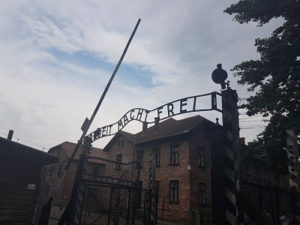
enter under the sign Arbeit Macht Frei – ‘Work will set you free’. The gates, where thousands of prisoners walked through every day. After a long days work they would come back through the gate, carrying the bodies of those who had died or been murdered.
Copious amounts of concrete, cold empty corridors not unlike the hearts of the SS men that used to patrol them. Barbed wire, electric fences and watchtowers EVERYWHERE. There was no running, no matter how bad it was in there.
Roll Call
Every morning and evening there was a roll call. This enabled them to keep track of deaths, transfers, new arrivals and escapes.
Many of these roll calls lasted hours, some in bad weather (rain, hail or shine) with many not surviving. During this time the SS would pick out the sick or exhausted to be sent direct to the gas chamber.
Blocks & Rooms
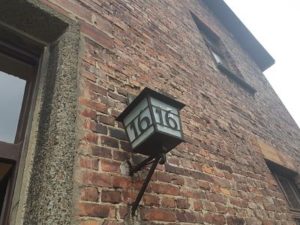 There are various blocks numbered and marked to show which are opened for entry.
There are various blocks numbered and marked to show which are opened for entry.
Further, there are permanent exhibitions prepared in co-operation with other countries that are well worth having a look at. English is provided on most if not all information boards.
Rooms displaying items confiscated from the arriving prisoners. Thousands of suitcases, hundreds of spectacles and piles and piles of shoes that belonged to men, women and children before they were sent to the gas chambers. These are heart breaking, maybe 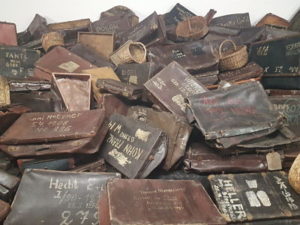 because they are something we can relate to or that they are items we own too.
because they are something we can relate to or that they are items we own too.

 One room holds 1,950kg of hair that had been cut off prisoners. Hair was also woven into hair cloth or sold to German companies. They used it in production of textiles and felt.
One room holds 1,950kg of hair that had been cut off prisoners. Hair was also woven into hair cloth or sold to German companies. They used it in production of textiles and felt.
Jews that had disabilities or who the SS men felt were unsuitable for slave labour were murdered in gas chambers immediately after arrival in Auschwitz. There is a large collection of prostheses lined up in a display case.
Bedding
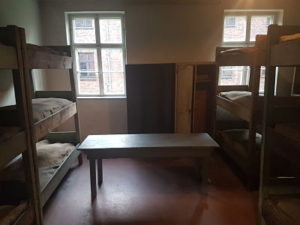 Initially when Auschwitz began the prisoners spent the night sleeping together on the floor, straw
Initially when Auschwitz began the prisoners spent the night sleeping together on the floor, straw
 or straw mats, on the floor. These were eventually replaced with three-tier bunks.
or straw mats, on the floor. These were eventually replaced with three-tier bunks.
As you can imagine the camp was overcrowded, a two story block had a capacity of about 700 prisoners, but in practice there were often more than that.
Summary
This time spent entrenched in history, in a time, we are most fortunate to have not been part of. Your heart aches for those that were though.
I am fortunate to have visited with Brett who has a large understanding of what happened. He could explain to Miss B and I, in simple terms when we had questions. We were very proud of Miss B’s maturity with the information she was confronted with. On top of our previous days discussions from previous sites visited, it’s a lot to take in.
We recommend buying a guide book from the bookshop on site to enhance your understanding during your visit.
BIRKENAU
After a sleep in with the sound of rain on the roof of the van. Where we stayed offer a late
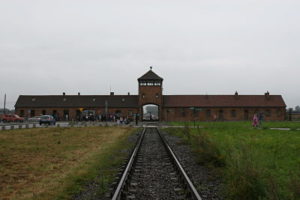
checkout of 5pm at our camp ground, basically, to allow for all visitors to Auschwitz to be back.
From 10am you can catch a FREE shuttle bus from Auschwitz I, leaving every ten minutes to Auschwitz II, Birkenau Memorial. This is only a 3.5km walk but as it was raining on and off we happily took the shuttle. The rain actually suited the visit perfectly, it somehow would not have felt right if it was bright blue sky and sunny.
I was very glad to split these two visits over two days giving me time to process what I had seen and read from yesterday.
Building of Auschwitz II (Birkenau) begun in 1941. The size of this camp on arrival through the gates is the first thing that hit me. Birkenau was built over 423 acres! It was the largest centre for the extermination (I dislike this word immensely) of Jews.
Barracks Wooden & Brick
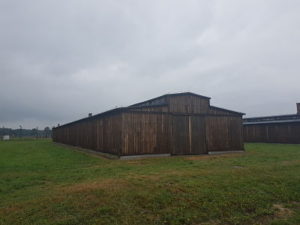 The wooden barracks designed to house 400, a windowless long room with the only light from
The wooden barracks designed to house 400, a windowless long room with the only light from  skylights. In each of the 18 stalls there was either a three tier bunk bed or sleeping platform for 15 prisoners.
skylights. In each of the 18 stalls there was either a three tier bunk bed or sleeping platform for 15 prisoners.
The brick barracks which housed 700 on 60 three tier bunks. Each of these 180 sleeping places housed anywhere up to 7 people each!
Prisoners slept on scattered straw, no pillows. When overcrowding occurred several people would have to share a blanket.
There were brick stoves connected by a chimney shaft that ran the length of the room. It is not hard to see their size would not be sufficient to heat the area required.
The Forest
Right down the back right corner there is a forest where they would sometimes leave prisoners awaiting, for their ‘turn’ in the gas chambers because it was already full.
There are pictures of men, women and children standing in the forest, the children unaware of what is going on.
The main camp bath house
The “Sauna” which from 1943 served as the reception and registration of new arrivals by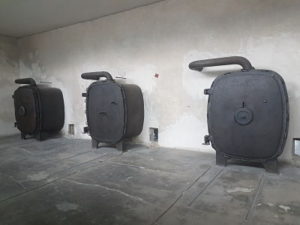 the SS. This is where their personal effects were confiscated, hair cut off, clothes taken and disinfected, bathed, given camp numbers and uniforms. This is where they were deprived of their individuality and transformed into numbers, an attempt at dehumanization. We walked this path while there and take you on the journey in our youtube video.
the SS. This is where their personal effects were confiscated, hair cut off, clothes taken and disinfected, bathed, given camp numbers and uniforms. This is where they were deprived of their individuality and transformed into numbers, an attempt at dehumanization. We walked this path while there and take you on the journey in our youtube video.
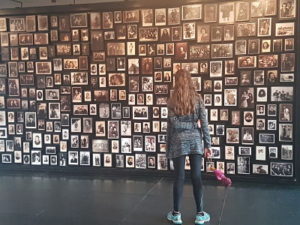
The most emotional moment of my visit was when at the end of that walk there is a collection of  private photographs.
private photographs.
Found after liberation in a room. The faces, the stories, the ages of some of the people, you can not, not be affected.
There is a memorial to all the victims. There is ruins of gas chambers and Crematoria to visit.
You can not help but be saddened and affected by what took place here, not that long ago really.
Along with our other visits of concentration camps while in Poland, travel is all about learning and this has added to our roadtrip experience.
We hope you enjoy your visit to Auschwitz & Birkenau.
To read more about our 2018 Europe Roadtrip click here.



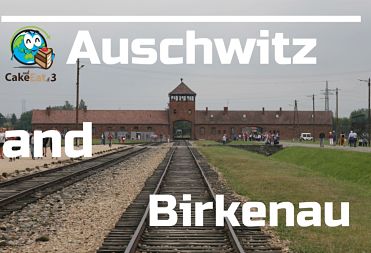
Comment here